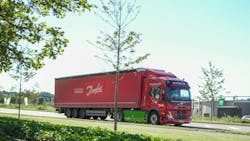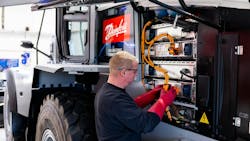The State of Electrification: Slow but Continued Growth Ahead
Development of electric vehicles for use in a range of applications — from passenger transport to trucking to construction — continues to rise. Although some OEMs have pulled back on their initial production plans in recent months due to current market conditions, the general consensus is electrification is here to stay.
In this first of a two-part interview series, Eric Azeroual, vice president of sales development and portfolio at Danfoss Editron, provides insight on the state of electrification today, key drivers for electric vehicle development and how he sees the electrification trend progressing.
*Editor’s Note: Questions and responses have been edited for clarity. Read part two of this interview "Energy Density and Charging are Technology Priorities for EV Advancement" for more on the technological advancements needed to aid further progression of electic vehicles.
Power & Motion (P&M): How do you view the current state of electrification?
Eric Azeroual (EA): It hasn't gone as fast as everybody predicted, for many reasons. One, electric vehicles are more expensive to purchase because of the batteries on board. You're basically purchasing a vehicle that's going to allow you to save money over time through fuel and maintenance savings, but you still have to front that capital, and interest rates are very, very high today.
There are two things that are happening. People are not buying new vehicles, and when they are, they're definitely not buying the more expensive vehicles, so that is impacting the rate of electrification, although it is still growing faster than traditional combustion engine vehicles.
Now that's the overall market perspective, but internally, what are we seeing from our customers that are developing electric vehicles? They haven't stopped. They're continuing to develop them and in fact, for passenger cars I think we're getting close to the fourth generation of electric vehicles. In commercial vehicles, we're at the second generation of electric vehicles, and now we're talking about the third generation which will go into the market by 2030.
For commercial vehicles, electric vehicle uptake is driven by legislation. Europe has been very vocal about its goals — zero-emission zones are one example — and in the U.S. we basically have California pushing the rest of the [country]. The legislation is highly influenced by Europe and they're trying to follow that in the U.S. as well.
In the U.S. what's really concerning is the change of governments. What is that going to do to electrification? Is that going to affect it or not? There will be an effect but we don't know how big it's going to be. If you take the example of the Biden administration, they put out a huge subsidy for electric school buses, billions of dollars, which basically means that every electric school bus today in the U.S. is almost free. The cost for the school is free, basically, because it's fully subsidized. So, if you have to renew your fleet, you're obviously going to choose to buy an electric school bus. The biggest thing for me, that's been really top of mind, is what's going to happen with the elections, if the government changes in the U.S. But in Europe, I think it's pretty set in stone and some big cities have [emissions] mandates such as Brussels, Amsterdam, Paris, and London. So, those big cities will continue driving electrification.
READ MORE: Danfoss Puts Volvo Electric Trucks into 24-Hour Service
P&M: What industries and/or applications is Danfoss Editron seeing the greatest uptake of electrification, and what is driving it? Is it the subsidies and legislation or are there other drivers as well?
EA: The biggest driver is legislation governments often come back with subsidy schemes to enable electrification.
The other thing that's not really spoken about is the pressure from China. China has developed this entire supply chain around electric vehicles, and they have excess capacity they want to export. They want to make sure their businesses are thriving and exploit these investments they’ve been putting into the electrification world for the last 15 years. We here in the U.S. and the rest of the world are trying to catch up with China, and they have the entire supply chain. What's pushing [the market] is also the electric offering from China that is becoming available; you don't have the barriers of getting the vehicle homologated, certified engines, the emission certifications that were basically pushing back on the Chinese to come to the rest of the world. I think there is a lot of pressure now [to enact] some tariffs against the Chinese vehicles [because some say] it's not fair, they're subsidizing it too much, they're selling [the electric vehicles] below their cost. My view is that tariffs will not work and will actually accelerate the regionalization and global presence of the Chinese suppliers on critical electric vehicle components.
In commercial vehicles, it's going to be the same because China has always been exporting commercial vehicles, just to places such as South America and Africa. You've never really seen them in the U.S. and in Europe, and that's basically because of two reasons. One, the homologation or certification of emissions that were very stringent in these countries. And two, because they didn't have a service and support network that was big enough to come to the U.S. or Europe. For commercial vehicles, it's all about 24 hours [service]; if my truck is down, I need it back up and running ASAP. That's what I think the Chinese electric vehicle manufacturers are going to need to work on if they really want to be competitive. It's not just about the cost of the truck, it's about the service. What's important is that they can deliver their goods from A to B. If they're stopped along the road, they're just not going to take the risk again. I think that's keeping the commercial vehicle [market] a bit harder to reach for the Chinese OEMs, but they will come.
Charing infrastructure is also a factor. There has been sufficient development in passenger cars so that you can take your car and, with a pretty high [level of] confidence, drive for thousands of kilometers and have areas to charge. But on the commercial vehicle side, it's really far from that. You have no fast charging stations that are capable of [charging those size vehicles]. You have a few pilot projects here and there, so that's what's also limiting [electrification from growing faster]. It's only growing in applications that allow overnight charging of a commercial vehicle, and that is pretty limited. It's any truck that does less than 200 km (124 mi.) a day, which is basically urban delivery trucks and school buses. That's it. Urban delivery and school buses are the best applications for electric commercial vehicles, and these are the ones electrifying. The rest of the market — heavy-duty trucks for example — is not electrifying, and that's also why the growth rate is lower than expected. It will take years for the commercial vehicle charging infrastructure to get there. It took Tesla to do it on the passenger vehicle side; Tesla [created charging infrastructure] and then everybody said ‘Oh, wow, wait a minute, now they own the charging infrastructure network, which is why they're selling a lot of cars, we need to do something.’ So then everybody [else in the market] got together and they created this big consortium, and that's how it [more charging infrastructure] happens. The same thing will need to happen in the commercial vehicle space, but it's going to be harder to pull off, because you're talking about megawatts of power to bring to a central location. It's not like you can do it everywhere.
P&M: How do you see electrification progressing in the next 5 years?
EA: It depends on the market. The way I see it, it's continuing to progress in Asia very fast because of the reasons we talked about. And I think that the big OEMs, the global companies, are serving Asia and so they're developing those solutions regardless and are ready to export them to the rest of the world when the markets are ready.
I see electrification continuing, but I think that we need to be very alert to the charging infrastructure and how to charge these vehicles. The ones who have made good headway on charging infrastructure and are offering a complete solution to their customers are going to be the ones that are the most successful.
In terms of growth, I see it's going to be between 20 and 30%; it's not something that you can underestimate. Before we were projecting 35%, but now we're being a bit more conservative. We'll see.
I like to say that we're all consumers. So, let's say you run a trucking company, and you happen to own an electric car. You're obviously comfortable with an electric vehicle which is going to change your mindset [on them in other applications]. I still hope that there's going to be more electric passenger cars and that’s going to influence the B2B (business to business) market as people become more comfortable with them. It's still not going to be on every route, but if we can get Amazon and Walmart to do all their deliveries with electric vehicles, then I think we're already getting rid of a lot of CO2 (carbon dioxide) emissions.
If you go to China sometime soon, you'll see that Shanghai has a blue sky again. I have been going to China for 15 years, and I hadn't seen the sky blue, so I was impressed. Electric, even though it is not zero emissions because you must mine [the materials], it does displace the emissions, so it does make a pretty good environment in the city.
READ MORE: Revenue Potential Increasing for Electric Truck Powertrain Components
About the Author
Sara Jensen
Executive Editor, Power & Motion
Sara Jensen is executive editor of Power & Motion, directing expanded coverage into the modern fluid power space, as well as mechatronic and smart technologies. She has over 15 years of publishing experience. Prior to Power & Motion she spent 11 years with a trade publication for engineers of heavy-duty equipment, the last 3 of which were as the editor and brand lead. Over the course of her time in the B2B industry, Sara has gained an extensive knowledge of various heavy-duty equipment industries — including construction, agriculture, mining and on-road trucks —along with the systems and market trends which impact them such as fluid power and electronic motion control technologies.
You can follow Sara and Power & Motion via the following social media handles:
X (formerly Twitter): @TechnlgyEditor and @PowerMotionTech
LinkedIn: @SaraJensen and @Power&Motion
Facebook: @PowerMotionTech

Leaders relevant to this article:




